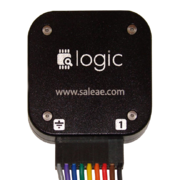Difference between revisions of "Saleae Logic"
Uwe Hermann (talk | contribs) m (→Photos) |
Uwe Hermann (talk | contribs) m (Voltages, thresholds.) |
||
| (5 intermediate revisions by 3 users not shown) | |||
| Line 1: | Line 1: | ||
[[File:Saleae Logic.png| | {{Infobox logic analyzer | ||
| image = [[File:Saleae Logic.png|180px]] | |||
| name = Saleae Logic | |||
| status = supported | |||
| source_code_dir = fx2lafw | |||
| channels = 8 | |||
| samplerate = 24MHz | |||
| samplerate_state = — | |||
| triggers = none (SW-only) | |||
| voltages = -0.5V — 5.25V | |||
| threshold = Fixed: VIH=2.0V—5.25V, VIL=-0.5V—0.8V | |||
| memory = none | |||
| compression = none | |||
| website = [http://www.saleae.com/logic/ saleae.com] | |||
}} | |||
The | The '''Saleae Logic''' is a USB-based, 8-channel logic analyzer with up to 24MHz sampling rate. | ||
The unit itself is very small, and has a USB 2.0 port connecting it to a PC (and powering the unit) and a connector for the 8 + 1 probe set. It is built around a Cypress EZ-USB FX2LP microcontroller — an 8051-compatible chip with built-in USB 2.0 controller. It can sample 8 channels up to 24MHz | The unit itself is very small, and has a USB 2.0 port connecting it to a PC (and powering the unit) and a connector for the 8 + 1 probe set. It is built around a Cypress EZ-USB FX2LP microcontroller — an 8051-compatible chip with built-in USB 2.0 controller. It can sample 8 channels up to 24MHz. | ||
In sigrok, we use the open-source [[fx2lafw]] firmware for this logic analyzer. | |||
See [[Saleae Logic/Info]] for more details (such as '''lsusb -vvv''' output) about the device. | See [[Saleae Logic/Info]] for more details (such as '''lsusb -vvv''' output) about the device. | ||
| Line 15: | Line 27: | ||
== Hardware == | == Hardware == | ||
* Main chip: Cypress CY7C68013A-56PVXC ( | * '''Main chip:''' Cypress CY7C68013A-56PVXC (FX2LP) | ||
* ESD protection: ST DVIULC6-4SC6 | * '''ESD protection''': ST DVIULC6-4SC6 | ||
* 3.3V voltage regulator: ST LD33C | * '''3.3V voltage regulator''': ST LD33C | ||
* I2C EEPROM: | * '''I2C EEPROM''': Microchip 24LC00 | ||
* Crystal: 24MHz | * '''Crystal''': 24MHz | ||
The case has four '''Torx T2''' screws you need to remove in order to be able to open it. | |||
== Photos == | == Photos == | ||
| Line 34: | Line 48: | ||
== Protocol == | == Protocol == | ||
Since we use the open-source [[fx2lafw]] firmware for this device, we don't need to know the protocol. | |||
However, for those interested in this, see our old [[Saleae_Logic/Info#Vendor_USB_protocol|vendor protocol docs]]. | |||
== Resources == | == Resources == | ||
* [http://downloads.saleae.com/Logic+Guide.pdf User's guide] | |||
* [http://www.saleae.com/downloads Vendor software] | |||
* [http://community.saleae.com/ SDKs] | |||
[[Category:Device]] | [[Category:Device]] | ||
[[Category:Logic analyzer]] | [[Category:Logic analyzer]] | ||
[[Category:Supported]] | |||
Latest revision as of 11:07, 28 July 2013
 | |
| Status | supported |
|---|---|
| Source code | fx2lafw |
| Channels | 8 |
| Samplerate | 24MHz |
| Samplerate (state) | — |
| Triggers | none (SW-only) |
| Min/max voltage | -0.5V — 5.25V |
| Threshold voltage | Fixed: VIH=2.0V—5.25V, VIL=-0.5V—0.8V |
| Memory | none |
| Compression | none |
| Website | saleae.com |
The Saleae Logic is a USB-based, 8-channel logic analyzer with up to 24MHz sampling rate.
The unit itself is very small, and has a USB 2.0 port connecting it to a PC (and powering the unit) and a connector for the 8 + 1 probe set. It is built around a Cypress EZ-USB FX2LP microcontroller — an 8051-compatible chip with built-in USB 2.0 controller. It can sample 8 channels up to 24MHz.
In sigrok, we use the open-source fx2lafw firmware for this logic analyzer.
See Saleae Logic/Info for more details (such as lsusb -vvv output) about the device.
See Saleae Logic16 for the successor product of the Saleae Logic.
Hardware
- Main chip: Cypress CY7C68013A-56PVXC (FX2LP)
- ESD protection: ST DVIULC6-4SC6
- 3.3V voltage regulator: ST LD33C
- I2C EEPROM: Microchip 24LC00
- Crystal: 24MHz
The case has four Torx T2 screws you need to remove in order to be able to open it.
Photos
Protocol
Since we use the open-source fx2lafw firmware for this device, we don't need to know the protocol.
However, for those interested in this, see our old vendor protocol docs.





